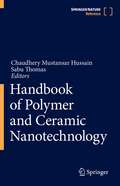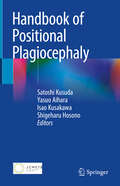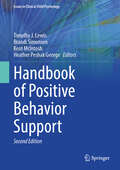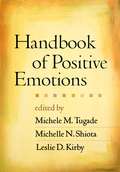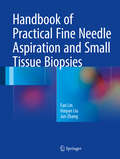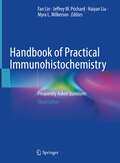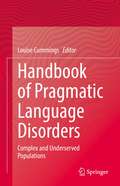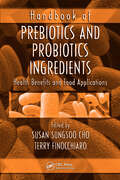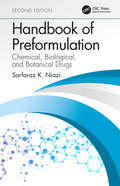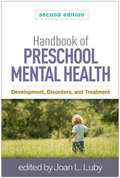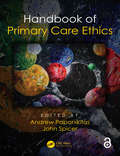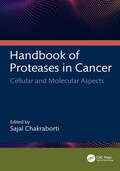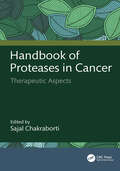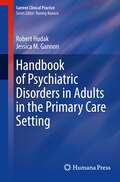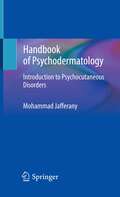- Table View
- List View
Handbook of Plant and Fungal Toxicants (Routledge Revivals)
by J. P. D'MelloFirst published in 1997. Natural toxicants are the subject of research throughout the world, and they are used for many purposes. The Handbook of Plant and Fungal Toxicants presents a wide range of compounds and considers how they relate to food safety, therapeutic purposes in medicine, and uses in breeding plants for enhanced resistance to insects and disease. Alkaloids, both from plant and fungal sources, are emphasized. Also covered are a variety of toxicants and phytochemicals including: bracken fern poisons polyphenolics gossypol flavones isoflavones pyrimidine glycosides fruit and vegetable allergens linear furanocoumarins photosensitizing agents nitrates oxalates Pinus ponderosa toxicantsThe text stresses the positive aspects of plant secondary compounds and presents examples of beneficial attributes in the context of environmental protection and human health. An international authorship addresses the global diversity and ecological distribution of plant and fungal toxicants. This handbook is ideal for senior-level college students and post-graduate students studying animal science, toxicology, and pharmaceutical sciences.
Handbook of Poisonous and Injurious Plants
by Michael J. Balick Lewis S. NelsonThis third edition of the Handbook of Poisonous and Injurious Plants is designed to assist the clinician in the initial response to the needs of a child or adult exposed to a poisonous or injurious plant. It highlights common and important plants that lead to the adverse effects upon exposure, and it describes the mechanisms of action of the implicated toxin, clinical manifestations, and specific therapeutics, as available, for each. This truly comprehensive resource is botanically rigorous with insights from both the pharmacognosy and medical literature. At the same time, it is also for those who are interested in growing and enjoying the plants in their environment, filling in a not-often-discussed botanical and horticultural niche that goes beyond their beautiful physical appearance. Plants contain many useful chemicals that humans have used for millennia as botanical curatives. This book will help the reader understand the fine balance between a medication and a poison, why plants contain these natural substances, and their impact on the human body. With its thorough references and full-color photos of hundreds of potentially toxic and injurious plants inside and outside the home, this book is useful for identifying and addressing concerns about cultivated species and those found in the wild. This book will be of interest to botanists, horticulturists, clinicians, and naturalists as well as hikers, gardeners, and all those who simply enjoy the wonders of nature and the great outdoors.
Handbook of Polymer and Ceramic Nanotechnology
by Sabu Thomas Chaudhery Mustansar HussainThis handbook examines the recent advances in the nanotechnology of polymers and ceramics, which possess outstanding mechanical properties and compatibility given their unique physical and chemical properties caused by the unusually large surface area to volume ratios and high interfacial reactivity. This handbook highlights the various compositions and morphologies of polymer and ceramic nanomaterials that can serve as powerful tools for the diverse applications in areas such as electronics, photonics, shape-memory alloys, biomaterials and biomedical nanomaterials, graphene-based technologies, and textiles and packaging. The handbook addresses safety, economics, green production and sustainability. The book contains a section on functionalization of these molecules, which only increases the possibility of developing even more versatile materials that can be fine-tuned for specific applications. Filling a gap in the literature, this handbook provides comprehensive coverage of properties, fabrication, characterization, functionalization methods and applications at both experimental and theoretical models scales. Economic, toxicological, regulatory, and environmental concerns regarding applications are also discussed in detail. Special attention is paid to sustainable approaches that reduce costs in terms of chemicals and time consumption. The book covers research trends, challenges, and prospective topics as well.
Handbook of Polytomous Item Response Theory Models
by Michael L. Nering Remo OstiniThis comprehensive Handbook focuses on the most used polytomous item response theory (IRT) models. These models help us understand the interaction between examinees and test questions where the questions have various response categories. The book reviews all of the major models and includes discussions about how and where the models originated, conceptually and in practical terms. Diverse perspectives on how these models can best be evaluated are also provided. Practical applications provide a realistic account of the issues practitioners face using these models. Disparate elements of the book are linked through editorial sidebars that connect common ideas across chapters, compare and reconcile differences in terminology, and explain variations in mathematical notation. These sidebars help to demonstrate the commonalities that exist across the field. By assembling this critical information, the editors hope to inspire others to use polytomous IRT models in their own research so they too can achieve the type of improved measurement that such models can provide. Part 1 examines the most commonly used polytomous IRT models, major issues that cut across these models, and a common notation for calculating functions for each model. An introduction to IRT software is also provided. Part 2 features distinct approaches to evaluating the effectiveness of polytomous IRT models in various measurement contexts. These chapters appraise evaluation procedures and fit tests and demonstrate how to implement these procedures using IRT software. The final section features groundbreaking applications. Here the goal is to provide solutions to technical problems to allow for the most effective use of these models in measuring educational, psychological, and social science abilities and traits. This section also addresses the major issues encountered when using polytomous IRT models in computerized adaptive testing. Equating test scores across different testing contexts is the focus of the last chapter. The various contexts include personality research, motor performance, health and quality of life indicators, attitudes, and educational achievement. Featuring contributions from the leading authorities, this handbook will appeal to measurement researchers, practitioners, and students who want to apply polytomous IRT models to their own research. It will be of particular interest to education and psychology assessment specialists who develop and use tests and measures in their work, especially researchers in clinical, educational, personality, social, and health psychology. This book also serves as a supplementary text in graduate courses on educational measurement, psychometrics, or item response theory.
Handbook of Positional Plagiocephaly
by Satoshi Kusuda Yasuo Aihara Isao Kusakawa Shigeharu HosonoThis comprehensive book provides details on infants' deformed scalps and the early detection of severe positional plagiocephaly. Many health professionals involved in infant health care believe that positional head shape changes are only temporary and will return to normal shape on their own. However, some of them may develop a deformed scalp shape later in life, which can result in malocclusion. Early and appropriate intervention may improve outcomes in patients with positional plagiocephaly; however, all healthcare professionals caring for infants must pay much more attention. The purpose of this book is to standardize the diagnosis and treatment of infants with positional plagiocephaly. This book addresses the prevention of head deformity in infancy as well as the most recently developed helmet therapy. Handbook of Positional Plagiocephaly is an official publication of the Japan Cranial Medical Examination and Treatment Society (JCMETS), published to raise awareness and foster understanding among health professionals involved in infant health care, such as pediatricians, pediatric neurosurgeons, pediatric surgeons, plastic surgeons, obstetricians, nurses, midwives, and parents. Professionals such as pediatricians and pediatric neurosurgeons contributed as chapter authors, resulting in content that is both comprehensive and easy to understand for readers of all levels.
Handbook of Positive Behavior Support (Issues in Clinical Child Psychology)
by Timothy J. Lewis Kent McIntosh Brandi Simonsen Heather Peshak GeorgeThis Second Edition of the handbook reflects the expanding growth and sophistication in research on positive behavior support (PBS). It synthesizes a large body of related research and is organized around school, district, and statewide multitiered systems of support logic that is widely prevalent in the field. The handbook organizes chapters into a powerful, dynamic knowledge base that covers theory, research, and applications. In addition, it offers a set of foundational chapters as well as addresses future directions in research and practice. Key areas of coverage include: Foundations and essential features of PBS. Implementation of PBS across K-12 educational settings. Program implementation (e.g., early childhood and alternative settings). Capacity building using PBS. The Handbook of Positive Behavior Support, Second Edition, a must-have resource for researchers, professors, and graduate students as wellas clinicians, therapists, and other professionals and practitioners in developmental, clinical child, and school psychology, social work, public health, child and adolescent psychiatry, family studies, pediatrics, and all related disciplines.
Handbook of Positive Emotions
by Barbara L. Fredrickson Michele M. Tugade Leslie D. Kirby Michelle N. ShiotaThis authoritative handbook reviews the breadth of current knowledge about positive emotions: their nature, functions, and consequences for individuals and society. Specific emotions are analyzed in depth, including happiness, pride, romantic love, compassion, gratitude, awe, challenge, and hope. Major theoretical perspectives are presented and cutting-edge research methods explained. The volume addresses neurobiological and physiological aspects of positive emotions as well as their social and intrapersonal contexts. Implications for physical health, coping, and psychopathology are explored, as are connections to organizational functioning and consumer behavior.
Handbook of Positive Psychology and Indian Thought Systems: Transforming Education for Well-being and Happiness
by Girishwar Misra Geetika Dutta Shalini GuptaThis handbook explores the intersection of positive psychology and Indian thought systems in education to create a generation of future citizens who are not only well-educated but also happy and well-rounded. It discusses mental hygiene, well-being, flow, resilience, gratitude, happiness, mindfulness, and happiness curriculum. With contributions from esteemed scholars and practitioners, this book offers comprehensive coverage of positive psychology, Indian thought systems, and their applications in education. It bridges the gap between theory and practice, providing readers with the knowledge and tools to create positive educational experiences that promote well-being, resilience, and happiness. The book is a valuable academic resource for practitioners and students in psychology, educational psychology and education. It is also helpful for parents, educators and anyone interested in promoting well-being and eternal happiness in our educational institutions and society.
Handbook of Positive Youth Development: Advancing Research, Policy, and Practice in Global Contexts (Springer Series on Child and Family Studies)
by Radosveta Dimitrova Nora WiiumThis handbook examines positive youth development (PYD) in youth and emerging adults from an international perspective. It focuses on large and underrepresented cultural groups across six continents within a strengths-based conception of adolescence that considers all youth as having assets. The volume explores the ways in which developmental assets, when effectively harnessed, empower youth to transition into a productive and resourceful adulthood. The book focuses on PYD across vast geographical regions, including Europe, Asia, Africa, Middle East, Australia, New Zealand, North America, and Latin America as well as on strengths and resources for optimal well-being. The handbook addresses the positive development of young people across various cultural contexts to advance research, policy, and practice and inform interventions that foster continued thriving and reduce the chances of compromised youth development. It presents theoretical perspectives and supporting empirical findings to promote a more comprehensive understanding of PYD from an integrated, multidisciplinary, and multinational perspective.The Handbook of Positive Youth Development in a Global Context is an essential resource for researchers, professors, and graduate students as well as clinicians, therapists, and other professionals in developmental, clinical child, and school psychology, public health and prevention science, family studies, cross-cultural psychology, child and adolescent psychiatry, social work, educational policy and politics, anthropology, sociology, social psychology and all interrelated disciplines.
Handbook of Practical Fine Needle Aspiration and Small Tissue Biopsies
by Fan Lin Jun Zhang Haiyan LiuThis handbook has been designed to provide a comprehensive and state-of-the art review and update of the major issues and challenges specific to fine needle aspiration (FNA) and small tissue core biopsies, which have emerged as primary modalities in establishing a definitive cancer diagnosis in the field of anatomic pathology, both in the U. S. and worldwide. Making an accurate diagnosis from a limited sample can be quite challenging yet crucial to patient care. The handbook, using the most current and evidence-based resources, will 1) emphasize a triple test (clinical, radiologic, and cytologic/histologic correlation); 2) stress the importance of cellblock preparation/small tissue core biopsy in modern cytopathology; 3) include over 100 diagnostic immunostaining panels/tables to address the utility and importance of ancillary studies; 4) incorporate relevant FISH and molecular tests into each chapter; and 5) summarize the pearls and pitfalls of FNA/small tissue biopsies at the beginning of each chapter. The book also includes highly practical presentations of typical case scenarios seen in an anatomic pathology laboratory. These are in the form of case presentations with step-by-step expert analysis. Sample cases include common but challenging situations, such as work-up of a tumor of unknown origin, evaluation of well-differentiated malignant tumors vs. benign/reactive lesions, identification of newly described tumor entities, and implementation of best practice in immunohistochemistry and molecular testing in a difficult case. Handbook of Practical Fine Needle Aspiration and Small Tissue Biopsies is written by recognized experts in their fields and provides a unique and valuable resource in the field of cytopathology, both for those currently in training and for those already in clinical practice at various skill levels. It represents a new, comprehensive yet concise resource on these timely and critical topics. v>
Handbook of Practical Immunohistochemistry
by Fan Lin Jeffrey PrichardIn a conceptually current, quick-reference, Question & Answer format, the Handbook of Practical Immunohistochemistry: Frequently Asked Questions provides standardization of the immunostaining process for each antibody and for each staining panel. With links to the authors Immunohistochemical Laboratory website, this volume creates a current and up-to-date information system on immunohistochemistry. This includes access to tissue microarrays (TMA) of over 5,000 tumors to validate common diagnostic panels and provide the best reproducible data for diagnostic purposes. Chapters are presented in a unique Question and Answer format. One table/IHC panel is provided to address each question. A concise explanatory note follows each table/panel to avoid diagnostic pitfalls. Website links are provided throughout to update the massive information in this field, providing the most current knowledge and the potential for live expert consultation. All chapters are written by nationally/internationally recognized experts in the related area ensuring authority and excellence. Comprehensive yet practical and concise, the Handbook of Practical Immunohistochemistry: Frequently Asked Questions, will be of great value for surgical pathologists, pathology residents and fellows, cytopathologists, and cytotechnologists.
Handbook of Practical Immunohistochemistry: Frequently Asked Questions
by Fan Lin Haiyan Liu Jeffrey W. Prichard Myra L. WilkersonAs in the second edition, the third edition of Handbook of Practical Immunohistochemistry – Frequently Asked Questions is written in a question and answer (Q&A) format and intended to be a practical, user-friendly, quick reference for information related to using the most up-to-date immunohistochemistry and in situ hybridization in clinical diagnosis. The new edition demonstrates a significant revision and improvement over the second edition. Five new chapters have been added that cover the following: 1) Immunohistochemistry: Leica’s perspective; 2) Immunohistochemistry: Maixin perspective; 3) RNA in situ hybridization: Applications in anatomic pathology; 4) Applications of rapid immunohistochemistry on frozen tissue sections during intraoperative pathologic diagnosis; and 5) Cutaneous lymphomas. In addition to extensive additions and changes, over 150 new questions and answers were added throughout this new edition. All chapters have been updated to include relevant new questions, new markers, more refined IHC panels, representative pictures, and current references. An extensive set of high-quality color pictures and diagnostic algorithms, if available, is included in each chapter to illustrate some of the key antibodies, including many recently discovered and substantiated antibodies used in that chapter.Written by experts in the field, Handbook of Practical Immunohistochemistry Third Edition is a comprehensive and practical guide for surgical pathologists, pathology residents and fellows, cytopathologists, and cytotechnologists.
Handbook of Practical Immunohistochemistry: Frequently Asked Questions
by Fan Lin and Jeffrey PrichardIn a conceptually current, quick-reference, Question & Answer format, the Handbook of Practical Immunohistochemistry: Frequently Asked Questions provides standardization of the immunostaining process for each antibody and for each staining panel. With links to the authors Immunohistochemical Laboratory website, this volume creates a current and up-to-date information system on immunohistochemistry. This includes access to tissue microarrays (TMA) of over 5,000 tumors to validate common diagnostic panels and provide the best reproducible data for diagnostic purposes.Chapters are presented in a unique Question and Answer format. One table/IHC panel is provided to address each question. A concise explanatory note follows each table/panel to avoid diagnostic pitfalls. Website links are provided throughout to update the massive information in this field, providing the most current knowledge and the potential for live expert consultation. All chapters are written by nationally/internationally recognized experts in the related area ensuring authority and excellence. Comprehensive yet practical and concise, the Handbook of Practical Immunohistochemistry: Frequently Asked Questions, will be of great value for surgical pathologists, pathology residents and fellows, cytopathologists, and cytotechnologists.
Handbook of Pragmatic Language Disorders: Complex and Underserved Populations
by Louise CummingsThis reference work is the first to examine pragmatic language disorders of clients in complex and underserved populations. In chapters written by a range of experts, the unique pragmatic language skills of clients are examined, allowing for a broad overview. The text gives focus to client groups with complex cognitive and psychiatric problems and children and adults that have been underserved by clinical language services because of maltreatment and social exclusion. Pragmatic disorders are examined in children with sensory loss, children who have been exposed to HIV and substance abuse, and adults with Huntington's disease and other complex neurodegenerative pathologies. This Handbook is an essential reference for researchers and clinicians in speech-language pathology, linguistics, psychology, and education.
Handbook of Prebiotics and Probiotics Ingredients: Health Benefits and Food Applications
by Susan Sungsoo Cho E. Terry FinocchiaroWhile there is little dispute that probiotics and prebiotics, alone and together, have been proven to promote gastrointestinal health and proper immune function, the challenge faced by researchers is finding not only the right combinations, but also finding those that are fully compatible with the formulation, processing, packaging, and distribution of functional foods. This volume comprehensively explores these variables and highlights the most current biological research and applications. It examines the sources of prebiotics and probiotics, describes the physiological functions of both products, and discusses promising applications for a plethora of disorders.
Handbook of Preformulation: Chemical, Biological, and Botanical Drugs, Second Edition
by Sarfaraz K. NiaziPreformulation studies are the physical, chemical, and biological studies needed to characterize a drug substance for enabling the proper design of a drug product, whereas the effectiveness of a drug product is determined during the formulation studies phase. Though the two disciplines overlap in practice, each is a significantly distinct phase of new drug development. Entirely focused on preformulation principles, this fully revised and updated Handbook of Preforumulation: Chemical, Biological, and Botanical Drugs, Second Edition provides detailed descriptions of preformulation methodologies, gives a state-of-the-art description of each technique, and lists the currently available tools useful in providing a comprehensive characterization of a new drug entity.
Handbook of Prenatal and Perinatal Psychology: Integrating Research and Practice
by Klaus Evertz Ludwig Janus Rupert LinderThe handbook synthesizes the comprehensive interdisciplinary research on the psychological and behavioral dimensions of life before, during, and immediately after birth. It examines how experiences during the prenatal period are associated with basic physiological and psychological imprints that last a lifetime and explores the ways in which brain networks reflect these experiences. Chapters offer findings on prenatal development, fetal programming, fetal stress, and epigenetics. In addition, chapters discuss psychotherapy for infants – before, during, and after birth – as well as prevention to promote positive health and well-being outcomes. Topics featured in this handbook include:Contemporary environmental stressors and adverse pregnancy outcomesThe psychology of newborn intensive care.Art therapy and its use in treating prenatal trauma.The failures and successes of Cathartic Regression Therapy.Prenatal bonding and its positive effects on postnatal health and well-being.The role of family midwives and early prevention.The cultural meaning of prenatal psychology. The Handbook of Prenatal and Perinatal Psychology is an essential resource for researchers, clinicians and related professionals, as well as graduate students in a wide range of interrelated disciplines, including developmental psychology, pediatric and obstetrical medicine, neuroscience, infancy and early child development, obstetrics and gynecology, nursing, social work, and early childhood education.
Handbook of Preschool Mental Health, Second Edition: Development, Disorders, and Treatment
by Joan L. LubyComprehensively exploring the development of psychiatric disorders in 2- to 6-year-olds, this authoritative handbook has been thoroughly revised to incorporate important scientific and clinical advances. Leading researchers examine how behavioral and emotional problems emerge and can be treated effectively during this period of rapid developmental and brain changes. Current knowledge is presented on conduct disorders, attention-deficit/hyperactivity disorder, anxiety disorders, depressive disorders, autism spectrum disorder, attachment disorders, and sleep disorders in very young children. The volume reviews a range of interventions for preschoolers and their caregivers--including clear descriptions of clinical techniques--and discusses the strengths and limitations of the empirical evidence base. New to This Edition *Many new authors; extensively revised with the latest research and empirically supported treatments. *Heightened focus on brain development and the neural correlates of disorders. *Section on risk and resilience, including chapters on sensitive periods of development and the early environment. *Chapters on parent-child interaction therapy, cognitive-behavioral therapies, attachment-based therapies, and translational approaches to early intervention.
Handbook of Primary Care Ethics
by John Spicer Andrew PapanikitasThis enterprising collection spans the breadth of primary care in multiple ways. Contributions from general practitioners, philosophers, nurses, physiotherapists, dentists, health economists, educationalists, patients and others reflect the rich variety that makes up primary care. Authors embrace the uncertainty inherent in the day-to-day reality of primary care, and practical advice sits alongside heartfelt accounts of issues that challenge practitioners. There is something here for everyone, whether the reader is looking for guidance on duties in primary care, a framework for analysing a difficult consultation, insights into the voice of the patient, or an understanding of the economics of primary care. Wendy Rogers, Professor of Clinical Ethics, Macquarie University With chapters revolving around practical issues and real-world contexts, this Handbook offers much-needed insights into the ethics of primary healthcare. An international set of contributors from a broad range of areas in ethics and practice address a challenging array of topics. These range from the issues arising in primary care interactions, to working with different sources of vulnerability among patients, from contexts connected with teaching and learning, to issues in relation to justice and resources. The book is both interdisciplinary and inter-professional, including not just ‘standard’ philosophical clinical ethics but also approaches using the humanities, clinical empirical research, management theory and much else besides. This practical handbook will be an invaluable resource for anyone who is seeking a better appreciation and understanding of the ethics ‘in’, ‘of’ and ‘for’ primary healthcare. That includes clinicians and commissioners, but also policymakers and academics concerned with primary care ethics. Readers are encouraged to explore and critique the ideas discussed in the 44 chapters; whether or not readers agree with all the authors’ views, this volume aims to inform, educate and, in many cases, inspire.
Handbook of Primate Behavioral Management
by Steven J. SchapiroKey features: Offers chapters by renowned experts which are comprised of three subunits: a theoretical discussion of the content area, a description of the methods employed to address the content area, and finally, and most importantly, a discussion of the ways that relevant aspects of the content area can be easily employed/adapted to enhance the behavioral management of NHPs Provides case studies that highlight the areas of expertise of the authors and emphasize ‘success stories’ that can be used to develop behavioral management strategies and build behavioral management programs Presents ‘Genera-specific’ chapters which focus on behavioral management strategies that, typically, are successfully employed with particular taxa of NHPs Includes a novel, pioneering ‘Product/services’ section that provides the producers of important technologies, equipment, and services with an opportunity to highlight the ways in which their products enhance the ability of their clients to manage the behavior of NHPs Illustrated with full color images and drawings throughout. The Handbook of Primate Behavioral Management (HPBM) fills a void in the scientific literature, providing those who work with nonhuman primates (NHPs) with a centralized reference for many issues related to the care and behavioral management of captive nonhuman primates. While there are numerous publications scattered throughout the literature that deal with the behavioral management of NHPs, this comprehensive handbook is the first single-source reference to summarize and synthesize this information. The HPBM is organized into six complementary parts starting with an introductory section. The book then provides in-depth coverage of content issues, applications and implementation, genera-specific chapters, technology-related questions involved in the behavioral management of NHPs, and a concluding section. Primate behavioral management is a topic that has recently generated a considerable number of primary publications in the scientific literature, mostly with an applied focus. Similarly, there are many primary publications currently available that address more basic issues related to the understanding of primate behavior. One of the principal goals of the HPBM is to highlight and synthesize basic science advances that can be adapted and applied to enhance the behavioral management of captive NHPs.
Handbook of Proteases in Cancer: Cellular and Molecular Aspects
by Sajal ChakrabortiThis handbook provides comprehensive coverage of the role of proteases and the associated biochemical pathways in cancer development and metastasis. Proteases make up about 2% of the human genome and play a critical role in the tumor microenvironment. Handbook of Proteases in Cancer: Cellular and Molecular Aspects introduces the major classes of proteases and the signal transduction mechanisms associated with cancer initiation and progression. It discusses the role of inflammation and immune responses in proteases-induced cancer. The book covers cancer-induced gene expression and apoptotic and necrotic pathways in cancer. This is useful for researchers and professionals in cancer research, biochemistry, and physiology. Key Features• Provides insights on the roles of proteases and anti-proteases in the tumor microenvironment.• Covers various cancer-induced apoptotic and necrotic pathways.• Discusses the mechanisms by which proteases induce an increase in inflammation, immuneresponse, and gene expression.• Covers the function of protease-activated receptors in cancer.• Reviews the different gene expression pathways and the ways they become erratic duringprotease-induced cancer.
Handbook of Proteases in Cancer: Therapeutic Aspects
by Sajal ChakrabortiThis handbook provides comprehensive coverage of the application of proteases in cancer therapy. Proteases make up to two percent of the human genome and play a critical role in the tumor microenvironment. The book delves into the applications of natural, synthetic, and non-coding RNAs in cancer therapy. It highlights how effective targeting of relevant proteases can help in cancer diagnosis and treatment. It covers the systems biology and bioinformatics approach in cancer drug development. The book is meant for researchers and professionals in cancer research, biochemistry, and physiology.
Handbook of Psychiatric Disorders in Adults in the Primary Care Setting (Current Clinical Practice)
by Robert Hudak Jessica M. GannonSince psychiatric training in medical school is brief in duration (often 4-8 weeks only), and minimal to nonexistent in many residency programs, most primary care physicians are not adequately equipped to treat psychiatric disorders, despite the fact that this role promises a significant portion of the average physician’s practice. This book provides non-psychiatric physicians, especially primary care physicians, with the tools to successfully diagnose and treat psychiatric disorders in their practices. Primary care physicians are the largest prescribers of psychiatric medications in the US, where they also provide the bulk of psychiatric diagnoses and treatment, especially in traditionally underserved areas. Every chapter is devoted to each of the major psychiatric disorders that a primary care physician is likely to encounter in clinical practice. They are formatted in a nearly identical way to make the text both easy to read and quickly peruse as a reference. Each chapter also includes a clinical description of the disorder, the proper method (including questions to ask, or screening tools, etc.) to make an accurate diagnosis, and differential diagnoses to consider. Additionally, appropriate treatment(s) for the diagnoses are indicated in a stepwise fashion. Chapters also contain information on medical tests that may be appropriate to order to rule out medical conditions, as well as details on proper routine health screening for individuals on specific medications and/or mental health diagnoses. To optimize accessibility of medication prescribing information, several tables of the medications that are commonly prescribed for each disorder will be indicated. This may lead to some redundancy of information, as there is considerable overlap in medication and dosing strategies for different illnesses, ex antipsychotics for bipolar disorder and schizophrenia and antidepressants for Major Depressive Disorder and Anxiety Disorders. However, duplication of information assists in readability and user friendliness, as doctors will not have to flip through different parts of a book or refer to an appendix every time they wish to look up specific medication related information. Written by experts in the field, Handbook of Psychiatric Disorders in Adults in the Primary Care Setting is a valuable resource to aid in the proper assessment and treatment of psychiatric disorders by the physicians who are most likely to see and treat these patients. Most psychiatric textbooks are probably not appropriate for most primary care physicians as they contain far too much specialized information that they do not need to know and do not often contain clinical steps and guidelines for treatment. This text fulfills a pressing clinical need.
Handbook of Psychocardiology
by Don Byrne Marlies E. AlvarengaThis handbook brings together the full weight of contemporary evidence bearing on what is now commonly termed "psycho-cardiology". It focuses on the role of psycho-social factors in the genesis and clinical management of cardiovascular disease (CVD). The book constitutes a critically reviewed compendium of current knowledge in the area, coupled with guides to evidence-based best practice in the field of psycho-cardiology. The following categories are covered: Social/demographic risk for CVD, Personality and CVD risk, Stress and CVD risk, Psychopathology (particularly affective disorders) and CVD risk, The psychological management of those with clinical CVD, Psychology in the prevention of CVD. The book integrates the evidence into a compelling argument that clinicians, researchers and those in public health will discount the role of psychological factors in regard to CVD at their own peril. And importantly for clinicians charged with the care of patients with CVD, the book poses the argument that failure to recognize the links between psychological factors and CVD may well be at the considerable peril of those patients under their care.
Handbook of Psychodermatology: Introduction to Psychocutaneous Disorders
by Mohammad JafferanyThis book provides valuable information to increase confidence in proper, effective management of patients with psychodermatolic conditions. Patients with psychocutaneous disease may present to multiple professionals to seek care. The multidimensional nature of the conditions can lead to specialists being fearful of how to properly manage patients. With the information provided in this book, healthcare providers can increase their comfort and become less hesitant when making decisions determining the proper treatment course and assessing the need for referral. Due to the cross-disciplinary nature of this topic, this book will have a large target audience: Healthcare providers from multiple diverse fields such as, but not limited to, family medicine, dermatology, and psychiatry.Dermatologists, Psychiatrists, general practitioners, dermatology and psychiatry residents, physician’s assistants, nurses, psychologists, and medical students with exposure to patients with psychocutaneous conditions and/or a special interest in the field may also benefit from the presented material. Professors, educators, and researchers with an interest in psychodermatology or interdisciplinary medicineThe Handbook of Psychodermatology will be a powerful resource as an aid in creating coursework material for undergraduate medical students specifically for psychiatry and/or dermatology lectures. In addition, it will be useful to graduate medical education teams creating curriculums for incoming residents in psychiatry, dermatology, family medicine, and pediatrics


